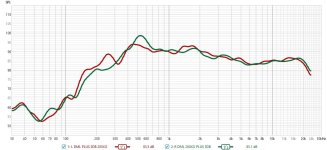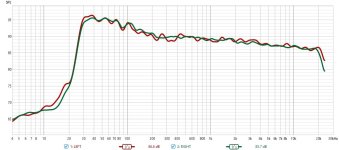This is the best I can do I'm afraid. The crossover was set to a 4th order Butterworth high pass filter @ 200hz. In theory the response should only have been 3db down @ 200hz. However, as you can see, it's much lower than this. My method of attaching the panel to the frame may be partly to blame.Can you please share how low your 60x40 cm panels play before they start to roll off (from the average level above say 100 Hz. or so)? Thank you.
Attachments
@homeswinghome
Hi Christian.
I've given the panels with the exciter not attached to a spine a more serious workout. It's definitely an improvement, to the point that I'm probably not going to bother with EPS. Response curve follows RTINGS to with 1db from 20hz to 20khz.
Simon.
Hi Christian.
I've given the panels with the exciter not attached to a spine a more serious workout. It's definitely an improvement, to the point that I'm probably not going to bother with EPS. Response curve follows RTINGS to with 1db from 20hz to 20khz.
Simon.
Attachments
Since my very beginning with DML, the bass roll off has been a mystery. We are getting now interesting information from the simulation. The first output of the simulation is the FR of the panel as it is mounted in a window of a giant wall that prevents the rear wave to interact with the front (half space). In such conditions, the FR extend to the lowest mode. In practice we see a roll off higher in frequency. The hypothesis is the front and rear waves cancellation like in an open baffle so in first approach linked to the dimensions of the panel compared to the sound speed in the air. A DML is much complex than a classical open baffle as the location of the source change with the frequency (anti-node location due to the mode shapes).Can you please share how low your 60x40 cm panels play before they start to roll off (from the average level above say 100 Hz. or so)? Thank you.
Christian
In my current understanding, a rigid spine interacts in 3 ways with the panel and its exciter:@homeswinghome
Hi Christian.
I've given the panels with the exciter not attached to a spine a more serious workout. It's definitely an improvement, to the point that I'm probably not going to bother with EPS. Response curve follows RTINGS to with 1db from 20hz to 20khz.
Simon.
- as a vertical support to avoid the long term deformation of the exciter spider due to its weight. I have no experience with exciters from Xcite but Dayton Audio like a DAEX25FHE it is mandatory.
- it stops the axial movement of the magnet and so the low frequency magnet resonance with 2 sub consequences:
- a change in the response at low frequency. Not fully clear for me but I think Eric shown the LF extension goes a bit lower with a free magnet. Maybe the free/fixed option of PETTaLS allows to get a better idea.
- a reduction of the distortion in fixed magnet. This is probably true only when the panel is acting without high pass filter. I can be check easily with REW.
- by an acoustic mechanism I not able to describe, the surfaces parallel at the panel on the rear side creates a resonance in the midrange. This already exist with the exciter alone but can be increased with a spider. It is the case in my plywood panel where the exciter is supported by a 10x10cm plywood part.
So the common position is a spider is mandatory for the long term and we can add design in a way not to add constraints on the exciter and of reduce dimensions in the panel plan.
Christian
I tried playing around with a Tectonic Elements BMR driver in a 46 x 50 cm sheet of wood. The bass falloff was very similar to that of my DML. This leads me to suspect something weird with the room. That said, DSP corrections in my miniDSP Flex sorts it all out very nicely. BTW, in my previous response curve, the frequency response follows the RTINGS curve from 30hz not 20hz. However, that's good enough as the lowest note on a bass is 41hz, and a piano 32hz. Only organ enthusiasts my feel the lack of another octave of bass extension!Since my very beginning with DML, the bass roll off has been a mystery.
I was playing some Philip Glass yesterday evening. Either the electricity was extra clean, or my ears were, but the system sounded very good indeed, with more of those leading and trailing edges apparent. The only place left to go now is either an amp upgrade or another DIY mains cable to my mains block based on the Russ Andrews Evolution 300 but at a fraction of the cost, and even that may not be an improvement on my Lapp Kabel DIY job.
Christian is correct in that the round flueted 6mm panel is my preferred material.@spedge
Steve, have you had any more thoughts on using Proplex or similar fluted polypropylene? Wickes do a 2400x1200 sheet of the 2mm thick stuff for £5.60.
My current panel is a 60x40cm bit of 2mm ceiba plywood semi-rigidly attached to a wood frame with spaced bits of 6mm thick foam glued to panel and frame. I'm using Xcite exciters which are a cut above what I was using before.
Bass duties are taken care of by H frame units with 15" drivers. Crossover & DSP is done via the miniDSP FLEX, with overall tuning to the RTINGS curve.
The square flutes have very flimsy walls which buckle and bend, the round flueted proplex panels are designed to withstand a forklift trucks weight.
It would be interesting to see how a 3mm or 4mm round flute would sound ?
I also tend to have a raised response in the lower frequencies, it just sounds more natural to me.
It also matches the sound from my headphones, giving me a more "being their " sound.
A lot of my panels tend to have a natural rising response in the lower midrange anyway, so no need for any EQ.
I just match the low frequency drivers response to match the panels response levels.
With my usual overlap of frequencies in the 100hz to 300hz or so depending on panel type.
It works for me 😃
Steve.
Zygadr used to have vary large panels , as I did in the early days.I just used random pink noise and ran it for about 100-150 samples. I used to use the ,moving mic method', but found a central position gave me the same results.
I also tried the Harman curve (same source as the one you mention), but found it a little lacking in the lower midrange.
I'm thinking of trying something other than ceiba ply. The sound is very 'safe', but lacks some transparency. Perhaps the ply is 'slower' than say EPS or Proplex leading to masked leading and trailing edges. It seems frequency response isn't everything!
Whatever panel material I decide on, I may try the late, great Zygadr's cloth tape mounting method.
I've lost track of Steve's (@spedge ) preferred damping method for EPS. I think it's sand both sides and apply 50/50 PVA/water to both sides. I just need to decide on EPS grade. Zygadr used to promote ultra high density stuff, whilst I think Steve prefers lower grades. I may hedge my bets and go for EPS100 which is one rung above standard EPS70.
he used 10mm HD eps , I used 25mm lower density eps
A 10mm 8ft tall low density EPS panel would not have been able to support itself and would have just flopped over, similar to the large 1mm ply panel I made the recording of.
He did not even get a chance to try my sanding technique.
I don't believe he got around to trying lower density materials before he passed away.
If you like the sound of ply , I would recommend using thin flexible ply.
I thought it was very good.
Steve.
Thanks Steve. Where do you get your panel material from, and is it branded 'Proplex'?Christian is correct in that the round flueted 6mm panel is my preferred material.
The 2mm ceiba ply I'm using seems to work very well. It's one of the least dense plys going and better than my older 3mm poplar ply jobs.If you like the sound of ply , I would recommend using thin flexible ply.
I thought it was very good.
With a peripheral suspension, the anti node of the first mode of the panel is a the center of the panel which gives it a behavior similar to an open baffle of about the same size with the driver not too far from the center. I guess this explain the similar bass roll off. Above the comparison is not possible as the anti nodes move, the driver of an open baffle has a fixed position.I tried playing around with a Tectonic Elements BMR driver in a 46 x 50 cm sheet of wood. The bass falloff was very similar to that of my DML. This leads me to suspect something weird with the room.
- Home
- Loudspeakers
- Full Range
- A Study of DMLs as a Full Range Speaker

